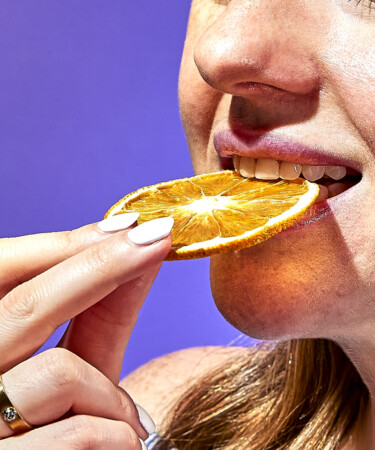If you’ve been to a true dive bar, maybe you’ve witnessed a bartender grab a slimy lime wedge from a sketchy-looking jar and mount it on the rim of your Gin & Tonic. On the other end of the spectrum, it’s now common to be presented with a showy drink topped with a tower of questionable flowers and trinkets designed to pop on your social feed. In either scenario, it’s natural to wonder: Is it OK to eat the garnish?
While some cocktails shine solo, we always appreciate when a good garnish amplifies the drinking experience, or at least provides us with a little snack. To find out which garnishes are cool to consume and which you should avoid, VinePair tapped Katie Kennedy, head bartender at Contento in NYC’s East Harlem.
Kennedy shares that in general, it’s safe to eat your cocktail garnish, but some finishing touches just aren’t meant to be consumed as part of the experience. “Garnishes like twists aren’t meant to be eaten, but they won’t hurt you if you do,” Kennedy says. “Eating a wedge of raw lemon isn’t my thing, but if it’s yours, go off.”
Some items used to top drinks obviously aren’t edible at all. While hopefully no one would try to eat a cocktail umbrella, more subtle ingredients like flowers are things to watch out for. While some varieties like orchids and violets are safe for consumption, it’s usually best to double-check with the staff.
“If you’re ever in doubt, just ask the bartender,” Kennedy says. “It won’t make you look dumb; it’s a chance to engage. A lot of thought goes into creating craft cocktails and I think most bartenders who care find the curiosity endearing.”
Even if the items placed on the rim of the glass are clearly edible, there are some red flags to watch out for before snacking on them.
“Cleanliness would be the biggest indicator to me,” Kennedy says. “Look at the way the garnishes are stored. Is the container clean? Are items being kept at the proper temperature? If something is being pulled out of a container that looks genuinely dirty then I wouldn’t eat it.”
There are some scenarios where the garnish is actually designed to be consumed as part of the full experience. “If a cocktail comes with a garnish that looks like a little snack, my favorite kind of garnish, then it is probably designed to complement and enhance the liquid in the glass and I would encourage you to eat it,” Kennedy explains. “A classic example would be olives in a Martini — the savory, salty burst to complement the botanicals in the spirit.”
At Contento, Kennedy tries to incorporate garnishes that serve a purpose, especially regarding sustainability: “We are in the day and age of social media and everyone drinking with their eyes first, so a lot of work goes into creating garnishes that are eye-catching but not always relevant to the flavor of the beverage,” she says.
So, if you see a caviar bump or blue cheese olive, they’ll probably add the perfect pop of flavor to your cocktail. But if the garnishes look dirty, it’s probably best to just order a side of bar nuts if you get hungry.
